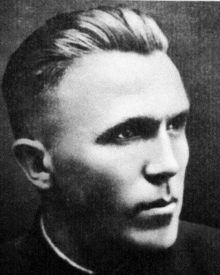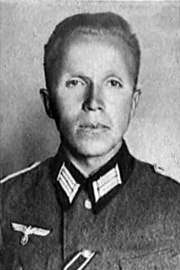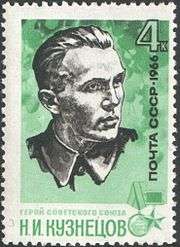Nikolai Ivanovich Kuznetsov
| Nikolai Kuznetsov | |
|---|---|
 | |
| Birth name | Nikanor Kuznetsov |
| Born |
July 27, 1911 Zyryanka village Perm Governorate, Russian Empire |
| Died |
March 9, 1944 (aged 32) Near Brody, Reichskommissariat Ukraine |
| Allegiance |
|
| Service/ | NKVD |
| Years of service | 1938–1944 |
| Awards |
|
Nikolai Ivanovich Kuznetsov (Russian: Николай Иванович Кузнецов) (July 27, 1911 – March 9, 1944) was a Soviet intelligence agent and partisan who operated in Nazi-occupied Ukraine (Reichskommissariat Ukraine) during World War II and who personally killed six high-ranking German officials. His file is still not fully disclosed and will be held until 2025 in the FSB archives. It was not until 1990 that Kuznetsov was officially recognized as a NKVD agent. He used several pseudonyms during his intelligence operations: e.g. Rudolf Schmidt, Nikolai Vasilevitsh Grachev (Николай Васильевич Грачёв) and Oberleutnant Paul Siebert. Kuznetsov was posthumously awarded the title Hero of the Soviet Union.
Biography

Kuznetsov was born into a peasant family of Russian ethnicity[1] in Perm Governorate (present-day Sverdlovsk Oblast). He studied forestry in a technical school and, after discovering his linguistic talents, learned the German, Esperanto, Polish, Ukrainian and Mordvinic languages (particularly Erzya language). In 1926, at age 15, Kuznetsov enrolled at Tyumen Agricultural College but did not finish and was forced to return home because of the death of his father. During that time Kuznetsov joined the ranks of the Komsomol. At home he enrolled in the local forestry college but in 1929 Kuznetsov was accused of having counter-revolutionary origins and excluded from Komsomol and the college. After moving in 1930 to Kudymkar (Komi-Permyak Autonomous Okrug) Kuznetsov was recruited by the local department of the OGPU. In 1932 he enrolled into Sverdlovsk Industrial Institute and continued to study German and other foreign languages.
In 1938 Kuznetsov moved to Moscow and joined the NKVD as an undercover agent, posing as an ethnic German and collecting intelligence about German diplomats in Moscow.[2]
When Germany invaded the Soviet Union Kuznetsov, at his own request, was sent to join Soviet partisan units in the Nazi-occupied Ukraine. In 1942, the same year he became a member of the Communist Party, he fought as a member of the guerrilla group "Victors", led by Dmitry Medvedev, in central and western Ukraine. Kuznetsov was in charge of several complex operations involving assassinations and kidnappings of high-ranking Nazi officials in the Rivne and Lviv regions, such as successful operations against the German-appointed chief judge of Ukraine, the vice-governor of Galicia, the adviser to the Reichskommissar of Ukraine, three German generals and others. Kuznetsov was also the first intelligence agent to uncover German plans to launch a massive tank attack in the Kursk region, and information about German V-2 rockets, as well as about Operation Long Jump, Hitler's plan to assassinate the heads of the USSR, USA and Great Britain during the Tehran Conference. Kuznetsov was operating in Rivne (the capital of Reichskommissariat Ukraine) using the fake German identity of Oberleutnant Paul Siebert. It was Kuznetsov who obtained information about the location of Hitler's "Werwolf" headquarters, near the city of Vinnitsya.
According to official Soviet version, Kuznetsov was killed in a firefight with members of the Ukrainian Insurgent Army near the city of Brody on March 9, 1944. In an alternative version by the Ukrainian Insurgent Army soldiers, Kuznetsov and his associates were detained in the village of Boratyn near Brody, dressed as German soldiers.[3] To avoid being discovered, Kuznetsov blew himself up on a grenade.[3]
Legacy

Nikolai Ivanovich Kuznetsov has been posthumously awarded the honorary title of Hero of the Soviet Union. A minor planet 2233 Kuznetsov discovered in 1972 by Soviet astronomer Lyudmila Zhuravlyova is named after him.[4] Kuznetsovsk, a city in Volhynia, was named after the Soviet agent (renamed in 2016 to Varash conforming to a law prohibiting names of Communist origin).[5]
Films about Kuznetsov
- Strong with Spirit («Сильные духом»)
- Special Operations Squad («Отряд специального назначения»)
- Genius of the intelligence («Гений разведки»)
Kuznetsov's victims
Kuznetzov's main target, Nazi Party official Erich Koch, survived World War II and outlived his Soviet "nemesis"; dying of old age in a Polish prison in 1986 at the age of 90.
- On September 20, 1943: the head of the financial department of the Reichskommissariat Ukraine, Minister Hans Gehl, and the Inspector General of Commissariat of the Rovno region, Adolf Winter, shot in the street in Rovno.
- On 15 November 1943: the chief of the Eastern Troops 740, Major General Max Iigen, abducted from his quarters in Rivne under the supervision and with the direct involvement of Kuznetsov.
- November 15, 1943: Paul Granau.
- On November 16, 1943: Senate president Oberfuhrer Alfred Funk, shot at the courthouse in Rovno.
- On February 9, 1944: Deputy Governor of Galicia District, Otto Bauer, and his secretary Heinrich Schneider, shot outside their quarters in Lviv.
Unsuccessful attempts
- April 20, 1943 - Erich Koch
- Summer 1943 - Erich Koch
- June 5, 1943 - Alfred Rosenberg
- September 30, 1943 - Paul Dargel
References
- ↑ "Герой Советского Союза Кузнецов Николай Иванович :: Герои страны (Hero of the Soviet Union Nikolai Ivanovich Kuznetsov)". warheroes.ru.
- ↑ Московские подвиги «Колониста»
- 1 2 Shpak, V. Legends of Nikolai Kuznetsov. Uryadovy Kuryer. 30 July 2011.
- ↑ Schmadel, Lutz D. (2003). Dictionary of Minor Planet Names (5th ed.). New York: Springer Verlag. p. 181. ISBN 3-540-00238-3.
- ↑ "Рада перейменувала Дніпродзержинськ на Кам'янське" (in Ukrainian). Українські Національні Новини. 19 May 2016. Archived from the original on May 19, 2016. Retrieved 19 May 2016.